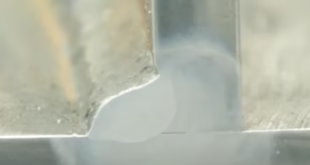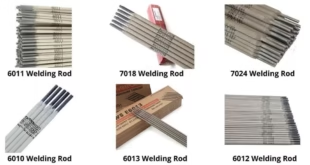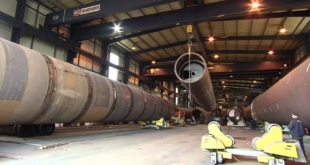What is Pipe Welding
Introduction
Pipe welding is a crucial aspect of many industries, including construction, manufacturing, and energy production. Welding involves the joining of two metals using heat, pressure, or both to create a permanent bond. The welding of pipes is especially important because pipes are used for the transportation of gases and liquids that are under pressure, and any flaws in the weld can lead to leaks, breaks, or even catastrophic accidents.
Pipe welding is a specialized welding technique used to join two pieces of metal pipe together. It is an essential skill used in many industries, including construction, oil and gas, and manufacturing. Pipe welding requires the welder to have a deep understanding of welding techniques, materials, and safety precautions. The welder must also have knowledge of the different types of metal alloys used in pipe fabrication and their unique properties.

Types of Welding Methods
There are several types of welding methods available, each with its own unique advantages and disadvantages. Understanding the different welding methods can help you choose the best technique for your project based on factors like the type of metal being used, the thickness of the material, and the desired outcome. In this section, we will discuss some of the most common types of welding methods in detail.
- TIG Welding: TIG (tungsten inert gas) welding is a type of welding that uses a non-consumable tungsten electrode to create the weld. The tungsten electrode is used to create an arc, which heats the metal and melts it together. A filler rod is often used to help fill any gaps between the two pieces of metal. TIG welding is known for producing high-quality welds, but it is also a slow process and requires a high level of skill and precision.
- MIG Welding: MIG (metal inert gas) welding is a type of welding that uses a consumable wire electrode to create the weld. The wire is fed through a welding gun and is melted by an electrical arc to fuse the two pieces of metal together. MIG welding is a fast and efficient process that is commonly used in industrial and manufacturing applications.
- Stick Welding: Stick welding, also known as shielded metal arc welding (SMAW), is a type of welding that uses a consumable electrode coated in flux to create the weld. The flux creates a protective shield around the weld to prevent oxidation and contamination. Stick welding is a versatile and cost-effective welding method that can be used in a variety of applications.
- Flux-Cored Arc Welding: Flux-cored arc welding (FCAW) is a type of welding that uses a continuous wire electrode and a flux-cored wire to create the weld. The flux in the wire creates a protective shield around the weld to prevent oxidation and contamination. FCAW is similar to MIG welding, but it is often used in applications where MIG welding is not practical or possible.
- Gas Welding: Gas welding is a type of welding that uses a fuel gas, such as acetylene, and an oxygen source to create the weld. The fuel gas and oxygen are mixed together in a welding torch to create a high-temperature flame that melts the metal and fuses it together. Gas welding is a versatile welding method that can be used for a variety of materials and thicknesses, but it is a slow process that requires a high level of skill.
- Plasma Arc Welding: Plasma arc welding is a type of welding that uses a highly concentrated plasma arc to melt the metal and create the weld. The plasma arc is created by passing a gas, such as argon, through a small nozzle and applying an electrical arc to ionize the gas. Plasma arc welding is a precise and versatile welding method that can be used for a variety of materials and thicknesses, but it is a specialized process that requires expensive equipment.
Pipe Welding Techniques
Pipe welding is a crucial aspect of many industries, including construction, manufacturing, and oil and gas. Proper welding techniques are essential for ensuring the safety, quality, and durability of welded joints. Here are some common pipe welding techniques:
- Shielded Metal Arc Welding (SMAW): Also known as stick welding, SMAW is a popular welding technique for pipes. In this method, a consumable electrode coated in flux is used to create an arc between the electrode and the pipe. The heat generated by the arc melts the electrode, and the flux creates a gas shield to protect the weld from atmospheric contamination.
- Gas Tungsten Arc Welding (GTAW): Also known as TIG welding, GTAW is a precision welding technique suitable for high-quality welds. In this method, a non-consumable tungsten electrode is used to create an arc between the electrode and the pipe. A separate filler metal is used to fill the joint, and a shielding gas protects the weld from atmospheric contamination.
- Gas Metal Arc Welding (GMAW): Also known as MIG welding, GMAW is a semi-automatic welding technique commonly used for large-diameter pipes. In this method, a wire electrode is fed through a welding gun and melted by a direct current. A shielding gas protects the weld from atmospheric contamination.
- Flux-Cored Arc Welding (FCAW): This technique is similar to GMAW, but a flux-cored wire is used instead of a solid wire. The flux in the wire creates a gas shield to protect the weld from atmospheric contamination, eliminating the need for an external shielding gas.
- Submerged Arc Welding (SAW): This is an automated welding technique suitable for high-production welding of large-diameter pipes. In this method, a welding head moves along the joint, and a continuous wire electrode is fed into the weld. The weld is submerged in a layer of flux, which protects it from atmospheric contamination.
Tools and Equipment Required for Pipe Welding
Welding Machine: The welding machine is the most critical piece of equipment for pipe welding. It provides the necessary power and heat to melt the metal and create the weld. Welding machines can use different welding processes, including TIG, MIG, and stick welding.
Welding Torch: The welding torch is a handheld tool that is used to control the welding process. It directs the flow of the shielding gas and electrode to the welding point. The torch can be used for TIG, MIG, and gas welding.
Welding Rods: Welding rods, also known as filler rods, are used to add material to the weld. They come in different sizes and materials, depending on the type of metal being welded. The rods are melted with the welding machine and added to the joint to fill any gaps.
Welding Wire: Welding wire is used for MIG and flux-cored welding. It is a consumable wire that is fed through the welding gun and melted to create the weld. The wire comes in different sizes and materials, depending on the type of metal being welded.
Shielding Gas: Shielding gas is used to protect the welding point from the air, which can cause oxidation and contamination. Different types of gases can be used, including argon, helium, and carbon dioxide, depending on the welding process and the type of metal being welded.
Welding Helmet: The welding helmet is worn to protect the welder’s eyes and face from the bright light and heat produced during the welding process. The helmet includes a filter lens that protects the eyes from harmful UV and IR radiation.
Welding Gloves: Welding gloves are specialized gloves designed to protect welders’ hands from high heat, sparks, and molten metal during the welding process. They are typically made from materials such as leather or heavy-duty synthetic fabrics that are heat-resistant and provide a barrier against burns and cuts.
Safety equipment: Safety equipment such as welding gloves, safety glasses, and a welding helmet are essential to protect the welder from the heat and sparks generated during the welding process.
Pipe stands: Pipe stands are used to hold the pipes in place during welding. They are designed to support the weight of the pipes and to allow the welder to work at the correct height.
Pipe cutters: Pipe cutters are used to cut the pipes to the correct length before welding. They are designed to cut the pipe cleanly and accurately.
Measuring tools: Measuring tools such as a tape measure and a level are used to ensure that the pipes are cut and positioned correctly.
Common Issues in Pipe Welding and How to Solve Them
In addition to these tools and equipment, pipe welders also need to have a good understanding of welding techniques and safety procedures. They need to be able to read and interpret welding blueprints and to work effectively as part of a team.
Pipe welding is a complex process that requires skill, experience, and attention to detail. Welding defects can arise if the welding process is not performed correctly. Here are some common issues in pipe welding and how to solve them:
1-Porosity Porosity is the presence of small holes or voids in the welded material. Porosity can weaken the weld and make it more susceptible to corrosion. The main causes of porosity are inadequate shielding gas coverage or contamination of the weld pool.
Solution: To avoid porosity, ensure that the welding area is clean and free of any contaminants, and use the appropriate shielding gas. A common shielding gas is argon, which prevents atmospheric gases from contaminating the weld pool.
2-Cracks Cracks are a significant concern in pipe welding as they can cause leaks and structural failure. Cracks can occur due to a lack of preheat or post-weld heat treatment or incorrect welding techniques.
Solution: To prevent cracking, ensure that the welding area is heated to the appropriate temperature before welding and follow the recommended welding techniques. Additionally, it’s important to perform post-weld heat treatment to relieve the internal stresses that can cause cracking.
3-Undercutting Undercutting occurs when the base metal near the weld is melted away, leaving a groove. This can weaken the weld and cause it to fail.
Solution: To prevent undercutting, it’s essential to use the correct welding technique and to maintain a consistent travel speed. It’s also important to use the appropriate electrode size and amperage to avoid excessive heat input, which can cause the base metal to melt away.
4-Lack of Fusion Lack of fusion occurs when the weld metal fails to fuse with the base metal or previously deposited weld metal. This can result in a weak or incomplete weld.
Solution: To prevent lack of fusion, it’s essential to use the correct welding technique and maintain the appropriate heat input. The welder should also ensure that the electrode is in contact with the base metal and that the welding angle is correct. Additionally, the welder should clean the base metal to remove any contaminants that could prevent the weld metal from fusing correctly.
FAQs
Is pipe welding a good career?
Pipe welding can be a good career for those who are interested in working in the construction, manufacturing, or maintenance industries. It requires skill and attention to detail, but can offer good pay and job stability.
What are the 4 different types of pipe welding positions?
The four different types of pipe welding positions are:
- 1G (flat position)
- 2G (horizontal position)
- 5G (horizontal fixed position)
- 6G (45-degree fixed position)
What is 2G 3G and 4G welding?
2G, 3G, and 4G welding refer to the three different horizontal welding positions. 2G is the horizontal position, 3G is the vertical-up position, and 4G is the overhead position.
What are the 5 basic weld types?
The five basic weld types are:
- Butt joint
- Corner joint
- Lap joint
- T-joint
- Edge joint
What is the best electrode for pipe welding?
The best electrode for pipe welding depends on the type of material being welded. Commonly used electrodes include E6010, E6011, E6013, E7018, and E7024.
What are the advantages of pipe welding?
Some advantages of pipe welding include:
- Strong, durable welds
- Ability to join different types of metals
- Cost-effective compared to other joining methods
- High productivity and efficiency
- Ability to create leak-tight seals in piping systems.
Conclusion
Pipe welding is a critical process that requires skill, experience, and attention to detail. Welding defects can arise if the welding process is not performed correctly, which can compromise the structural integrity of the pipes and lead to leaks or failures. To prevent these issues, it’s important to follow the necessary safety precautions and use the appropriate welding techniques and equipment.
 Welding of Welders All about Welding and Welders
Welding of Welders All about Welding and Welders



